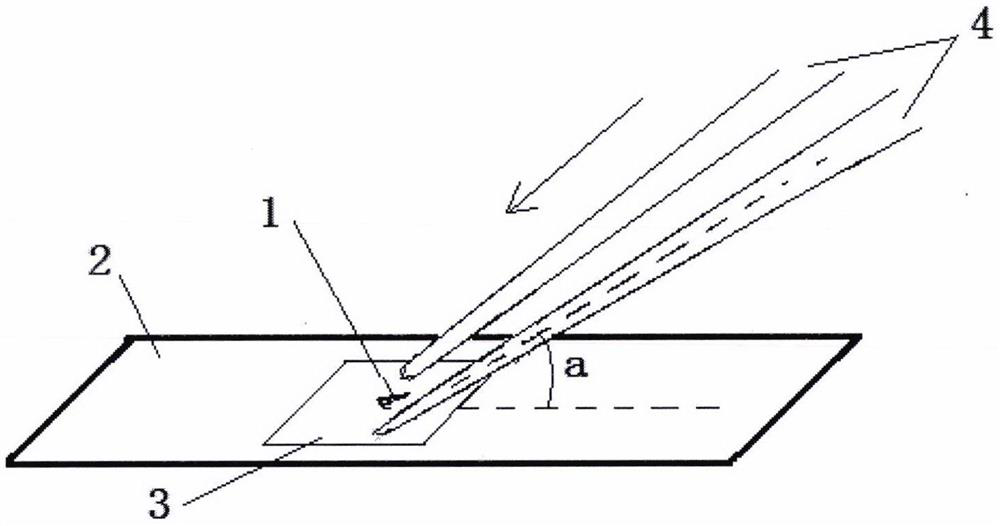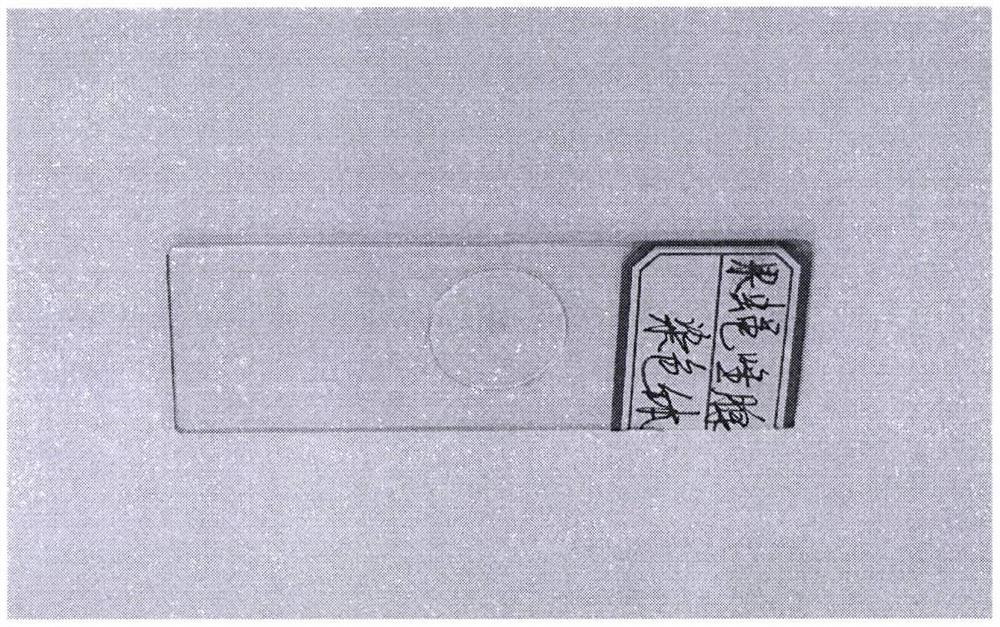Manufacturing method of fruit fly salivary gland chromosome permanent loading slide
A production method and chromosome technology, applied in the preparation of test samples, measuring devices, sampling, etc., can solve the problems of not particularly stable operation, poor salivary gland extension, and the effect needs to be improved, so as to be easy to master and overcome the production of clothing pieces Unsatisfactory results, avoid poor stretching or even destroyed effects
- Summary
- Abstract
- Description
- Claims
- Application Information
AI Technical Summary
Problems solved by technology
Method used
Image
Examples
Embodiment 1
[0023] ① Obtain salivary glands: dissect the third instar larvae of Drosophila, obtain salivary gland 1 and remove the fat body; then clean up the sundries around salivary gland 1 on slide 2;
[0024] ②Staining: Routine staining of salivary gland 1;
[0025] ③Pressioning: cover the cover glass 3, place the two feet of the tweezers 4 on the cover glass 3 on both sides of the salivary gland 1, the angle a between the two feet of the tweezers 4 and the slide glass 2 is 30° , and then force downwards obliquely along the direction of the tweezers feet, and the direction of force is as follows figure 1 As indicated by the arrow, the cover glass 3 is in close contact with the slide glass 2 and at the same time slides horizontally relative to the slide glass 2. When the cover glass 3 is close to the slide glass 2 and the cover glass 3 When the excess dye solution below is squeezed out, stop using force, and pay attention to that the cover glass 3 should not slide relative to the slid...
Embodiment 2
[0028] ① Obtain salivary glands: dissect the third instar larvae of Drosophila, obtain salivary gland 1 and remove the fat body; then clean up the sundries around salivary gland 1 on slide 2;
[0029] ② Staining: Perform routine staining on salivary gland 1; after staining, remove excess dye solution, add 1 drop of Carnoy's fixative solution on salivary gland 1, and fix for 0.5 minutes;
[0030] ③Pressioning: cover the cover glass 3, place the two feet of the tweezers 4 on the cover glass 3 on both sides of the salivary gland 1, and the angle a between the two feet of the tweezers 4 and the slide glass 2 is 60° , and then force downwards obliquely along the direction of the tweezers feet, and the direction of force is as follows figure 1 As indicated by the arrow, the cover glass 3 is in close contact with the slide glass 2 and at the same time slides horizontally relative to the slide glass 2. When the cover glass 3 is close to the slide glass 2 and the cover glass 3 When th...
Embodiment 3
[0033] ① Obtain salivary glands: dissect the third instar larvae of Drosophila, obtain salivary gland 1 and remove the fat body; then clean up the sundries around salivary gland 1 on slide 2;
[0034] ② Staining: Perform routine staining on salivary gland 1; after staining, remove excess dye solution, add 2 drops of Carnoy's fixative solution on salivary gland 1, and fix for 2 minutes;
[0035] ③Pressioning: cover the cover glass 3, place the two feet of the tweezers 4 on the cover glass 3 on both sides of the salivary gland 1, and the angle a between the two feet of the tweezers 4 and the slide glass 2 is 45° , and then force downwards obliquely along the direction of the tweezers feet, and the direction of force is as follows figure 1 As indicated by the arrow, the cover glass 3 is in close contact with the slide glass 2 and at the same time slides horizontally relative to the slide glass 2. When the cover glass 3 is close to the slide glass 2 and the cover glass 3 When the...
PUM
 Login to View More
Login to View More Abstract
Description
Claims
Application Information
 Login to View More
Login to View More - R&D
- Intellectual Property
- Life Sciences
- Materials
- Tech Scout
- Unparalleled Data Quality
- Higher Quality Content
- 60% Fewer Hallucinations
Browse by: Latest US Patents, China's latest patents, Technical Efficacy Thesaurus, Application Domain, Technology Topic, Popular Technical Reports.
© 2025 PatSnap. All rights reserved.Legal|Privacy policy|Modern Slavery Act Transparency Statement|Sitemap|About US| Contact US: help@patsnap.com



